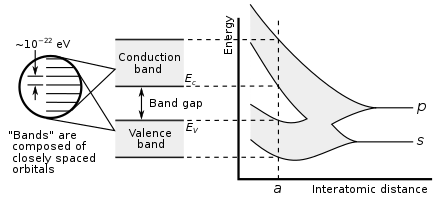ബാന്റ് ഗ്യാപ്
(Band gap എന്ന താളിൽ നിന്നും തിരിച്ചുവിട്ടതു പ്രകാരം)
സോളിഡ് സ്റ്റേറ്റ് ഫിസിക്സിൽ ബാന്റ് ഗ്യാപ് (band gap, energy gap, അല്ലെങ്കിൽ bandgap) എന്നെല്ലാം അറിയപ്പെടുന്നത് ഒരു ഖരത്തിൽ ഇലക്ടോണുകൾക്ക് സ്ഥിതി ചെയ്യാൻ സാധ്യമല്ലാത്ത ഒരു ഊർജ്ജ മേഖലയെയാണ്.

സെമികണ്ടക്ടർ ഫിസിക്സിൽ
തിരുത്തുകബാന്റ് ഗ്യാപ്പുകളുടെ പട്ടിക
തിരുത്തുക| Group | Material | Symbol | Band gap (eV) @ 302K | Reference |
|---|---|---|---|---|
| III-V | Aluminium nitride | AlN | 6.0 | [1] |
| IV | Diamond | C | 5.5 | [2] |
| IV | Silicon | Si | 1.14 | |
| IV | Germanium | Ge | 0.67 | [3] |
| III–V | Gallium nitride | GaN | 3.4 | |
| III–V | Gallium phosphide | GaP | 2.26 | |
| III–V | Gallium arsenide | GaAs | 1.43 | |
| IV–V | Silicon nitride | Si3N4 | 5 | |
| IV–VI | Lead sulfide | PbS | 0.37 | |
| IV–VI | Silicon dioxide | SiO2 | 9 | [4] |
| Copper oxide | Cu2O | 2.1 | [5] |
പദാർത്ഥങ്ങൾ
തിരുത്തുകഇലക്ട്രോണിൿ വിഷയങ്ങളുടെ പട്ടിക
തിരുത്തുക- Electronics
- Bandgap voltage reference
- Condensed matter physics
- Direct and indirect bandgaps
- Electrical conduction
- Electron hole
- Field-effect transistor
- Light-emitting diode
- Photodiode
- Photoresistor
- Photovoltaics
- Solar cell
- Solid state physics
- Semiconductor
- Semiconductor devices
- Strongly correlated material
- Valence band
ഇവയും കാണുക
തിരുത്തുകഅവലംബം
തിരുത്തുക- ↑ Feneberg, Martin; Leute, Robert A. R.; Neuschl, Benjamin; Thonke, Klaus; Bickermann, Matthias (2010). "High-excitation and high-resolution photoluminescence spectra of bulk AlN". Physical Review B. 82 (7). doi:10.1103/PhysRevB.82.075208. ISSN 1098-0121.
- ↑ Kittel, Charles. Introduction to Solid State Physics, 7th Edition. Wiley.
- ↑ Streetman, Ben G.; Sanjay Banerjee (2000). Solid State electronic Devices (5th ed.). New Jersey: Prentice Hall. p. 524. ISBN 0-13-025538-6.
- ↑ Vella, E.; Messina, F.; Cannas, M.; Boscaino, R. (2011). "Unraveling exciton dynamics in amorphous silicon dioxide: Interpretation of the optical features from 8 to 11 eV". Physical Review B. 83 (17): 174201. Bibcode:2011PhRvB..83q4201V. doi:10.1103/PhysRevB.83.174201.
- ↑ Baumeister, P.W. (1961). "Optical Absorption of Cuprous Oxide". Physical Review. 121 (2): 359. Bibcode:1961PhRv..121..359B. doi:10.1103/PhysRev.121.359.
പുറത്തേക്കുള്ള കണ്ണികൾ
തിരുത്തുക- Direct Band Gap Energy Calculator Archived 2008-05-15 at the Wayback Machine.
- Moriarty, Philip. "Energy Gap (and what makes glass transparent?)". Sixty Symbols. Brady Haran for the University of Nottingham.